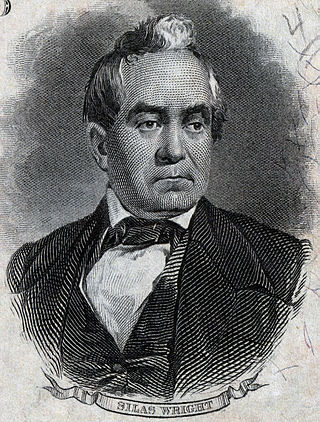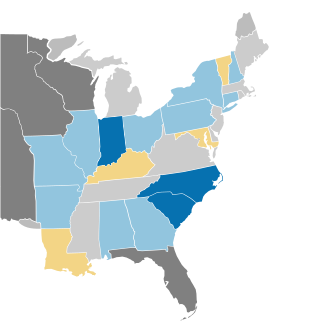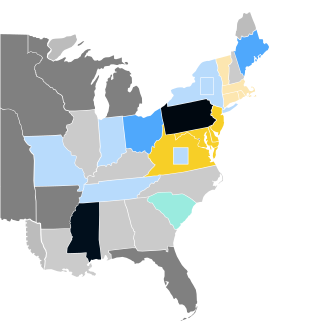The 1833 United States Senate special election in New York was held on January 4, 1833, by the New York State Legislature to elect a U.S. Senator (Class 3) to represent the State of New York in the United States Senate.
| Elections in New York State |
|---|
 |
The 1833 United States Senate special election in New York was held on January 4, 1833, by the New York State Legislature to elect a U.S. Senator (Class 3) to represent the State of New York in the United States Senate.
William L. Marcy had been elected in 1831 to this seat. In November 1832, Marcy was elected Governor, and upon taking office resigned his Senate seat on January 1, 1833.
At the State election in November 1832, a very large Jacksonian-Democratic majority was elected to the Assembly, and six of the eight State Senators elected were Jacksonian Democrats. The 56th New York State Legislature met from January 1 to April 30, 1833, at Albany. The party strength in the Assembly as shown by the election for Speaker was: 99 for Jacksonian Democrat Charles L. Livingston and 22 for Anti-Mason John C. Spencer.
New York State Comptroller Silas Wright, Jr., was the candidate of the Jacksonian Democrats.
Silas Wright, Jr., was the choice of both the Assembly and the Senate, and was declared elected.
| Office | Candidate | Party | Senate (32 members) | Assembly (128 members) |
|---|---|---|---|---|
| U.S. Senator | Silas Wright, Jr. | Jacksonian | 24 | 99 |
| John C. Spencer | Anti-Mason | 3 | 8 | |
| James Burt | 1 | 2 | ||
| Gerrit Smith | 1 | 1 | ||
| James Kent | 4 | |||
| Albert Gallatin | 3 | |||
| Gideon Hawley | 3 | |||
| John Birdsall | Anti-Mason | 1 | ||
| Myron Holley | 1 | |||
| William Thompson | 1 | |||
| Albert H. Tracy | Anti-Mason | 1 | ||
| Samuel A. Foot | 1 | |||
Wright took his seat on January 14, 1833, was re-elected twice (in 1837 and 1843) and remained in office until November 1844 when he resigned after his election as Governor of New York.
Comptroller Wright's election to the U.S. Senate produced a shuffle in the State's administration: Secretary of State Azariah C. Flagg succeeded Wright as Comptroller; Adjutant General John Adams Dix succeeded Flagg as Secretary of State; and Levi Hubbell was appointed Adjutant General of the State Militia.

Silas Wright Jr. was an American attorney and Democratic politician. A member of the Albany Regency, he served as a member of the United States House of Representatives, New York State Comptroller, United States Senator, and Governor of New York.

The 1831 United States Senate election in New York was held on February 1, 1831, by the New York State Legislature to elect a U.S. Senator to represent the State of New York in the United States Senate.

The 1833 United States Senate election in New York was held on February 5, 1833 by the New York State Legislature. Interim Senator Charles E. Dudley was not put forward for re-election to a full term. Jacksonian Nathaniel P. Tallmadge was elected to succeed him after narrowly winning a Jacksonian legislative caucus over Benjamin F. Butler. He then narrowly won majorities in both houses of the legislature.

The 1837 United States Senate election in New York was held on February 7, 1837, by the New York State Legislature to elect a U.S. Senator to represent the State of New York in the United States Senate.

The 1839—1840 United States Senate election in New York was held on February 5, 1839 and January 14, 1840. Incumbent Senator Nathaniel P. Tallmadge was re-elected to a second term in office over scattered opposition.

The 1843 United States Senate election in New York was held on February 7, 1843, by the New York State Legislature to elect a U.S. Senator to represent the State of New York in the United States Senate.

The 1845 United States Senate special election in New York was held on January 18, 1845 by the New York State Legislature to elect two U.S. Senators to represent the State of New York in the United States Senate. The regular 1845 United States Senate election in New York was held on February 4, 1845, to elect a U.S. Senator to represent the State of New York in the United States Senate.

The 1842–43 United States Senate elections were held on various dates in various states. As these U.S. Senate elections were prior to the ratification of the Seventeenth Amendment in 1913, senators were chosen by state legislatures. Senators were elected over a wide range of time throughout 1842 and 1843, and a seat may have been filled months late or remained vacant due to legislative deadlock. In these elections, terms were up for the senators in Class 3.

The 1836–37 United States Senate elections were held on various dates in various states. As these U.S. Senate elections were prior to the ratification of the Seventeenth Amendment in 1913, senators were chosen by state legislatures. Senators were elected over a wide range of time throughout 1836 and 1837, and a seat may have been filled months late or remained vacant due to legislative deadlock. In these elections, terms were up for the senators in Class 3.

The 1832–33 United States Senate elections were held on various dates in various states. As these U.S. Senate elections were prior to the ratification of the Seventeenth Amendment in 1913, senators were chosen by state legislatures. Senators were elected over a wide range of time throughout 1832 and 1833, and a seat may have been filled months late or remained vacant due to legislative deadlock. In these elections, terms were up for the senators in Class 1.

The 1830–31 United States Senate elections were held on various dates in various states. As these U.S. Senate elections were prior to the ratification of the Seventeenth Amendment in 1913, senators were chosen by state legislatures. Senators were elected over a wide range of time throughout 1830 and 1831, and a seat may have been filled months late or remained vacant due to legislative deadlock. In these elections, terms were up for the senators in Class 3.

The 49th New York State Legislature, consisting of the New York State Senate and the New York State Assembly, met from January 3 to April 18, 1826, during the second year of DeWitt Clinton's second tenure as Governor of New York, in Albany.

The 52nd New York State Legislature, consisting of the New York State Senate and the New York State Assembly, met from January 6 to May 5, 1829, during the short tenure of Martin Van Buren as Governor of New York, and—after Van Buren's resignation—during the first year of Enos T. Throop's governorship, in Albany.

The 55th New York State Legislature, consisting of the New York State Senate and the New York State Assembly, met from January 3 to July 2, 1832, during the fourth year of Enos T. Throop's governorship, in Albany.

The 56th New York State Legislature, consisting of the New York State Senate and the New York State Assembly, met from January 1 to April 30, 1833, during the first year of William L. Marcy's governorship, in Albany.

The 57th New York State Legislature, consisting of the New York State Senate and the New York State Assembly, met from January 7 to May 6, 1834, during the second year of William L. Marcy's governorship, in Albany.

The 59th New York State Legislature, consisting of the New York State Senate and the New York State Assembly, met from January 5 to May 26, 1836, during the fourth year of William L. Marcy's governorship, in Albany.

The 65th New York State Legislature, consisting of the New York State Senate and the New York State Assembly, met from January 4 to September 7, 1842, during the fourth year of William H. Seward's governorship, in Albany.

The 67th New York State Legislature, consisting of the New York State Senate and the New York State Assembly, met from January 2 to May 7, 1844, during the second year of William C. Bouck's governorship, in Albany.

The 68th New York State Legislature, consisting of the New York State Senate and the New York State Assembly, met from January 7 to May 14, 1845, during the first year of Silas Wright's governorship, in Albany.